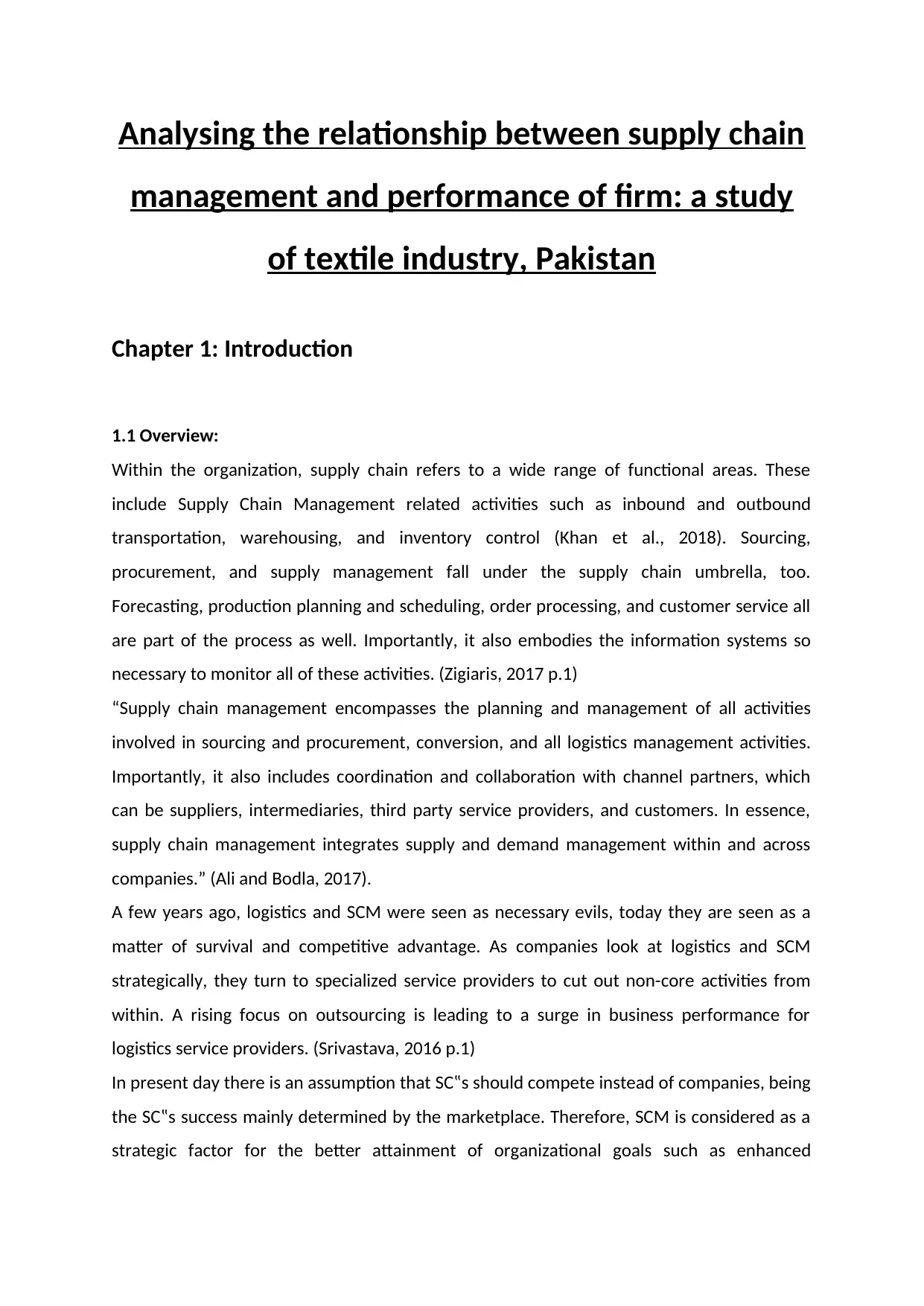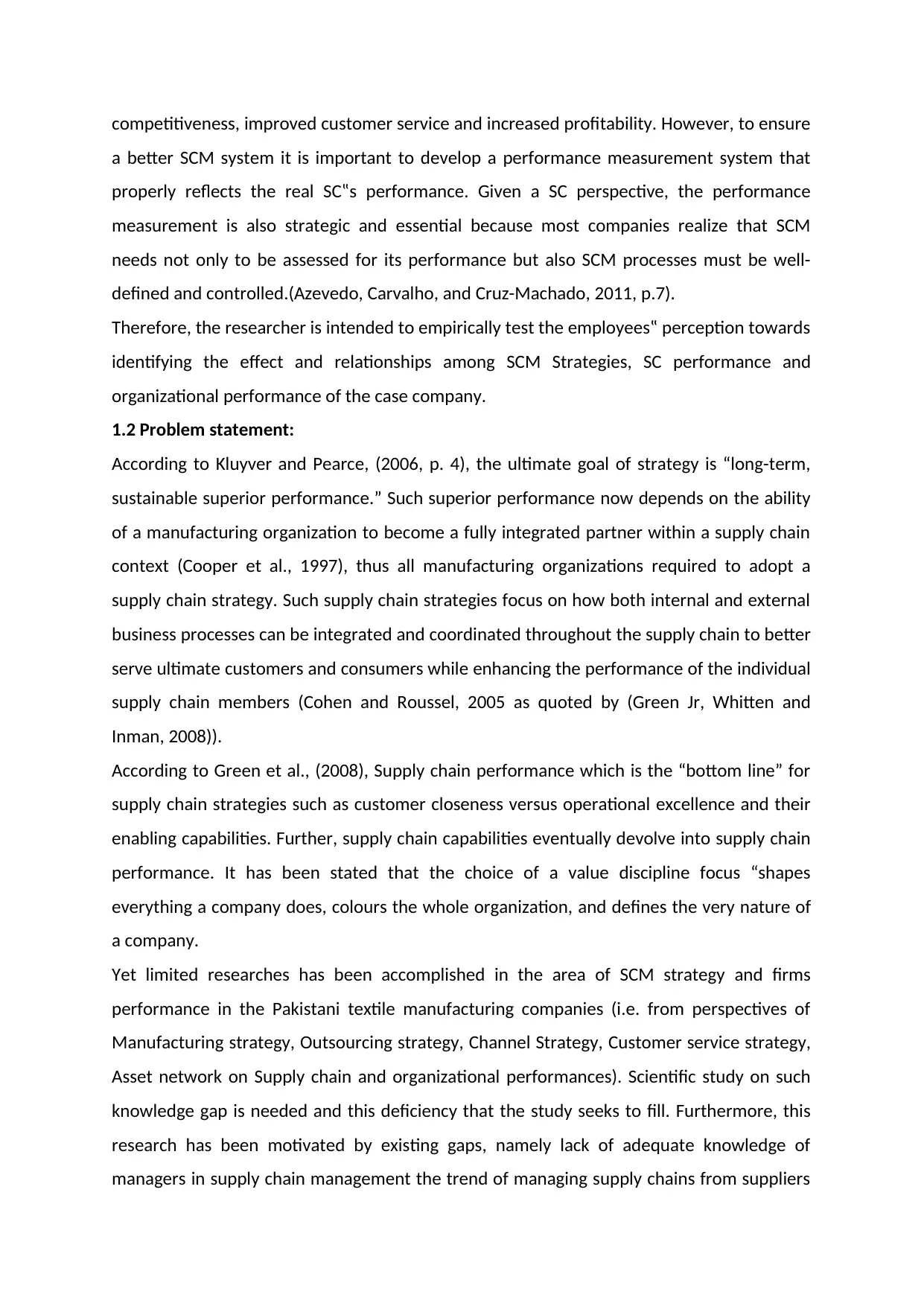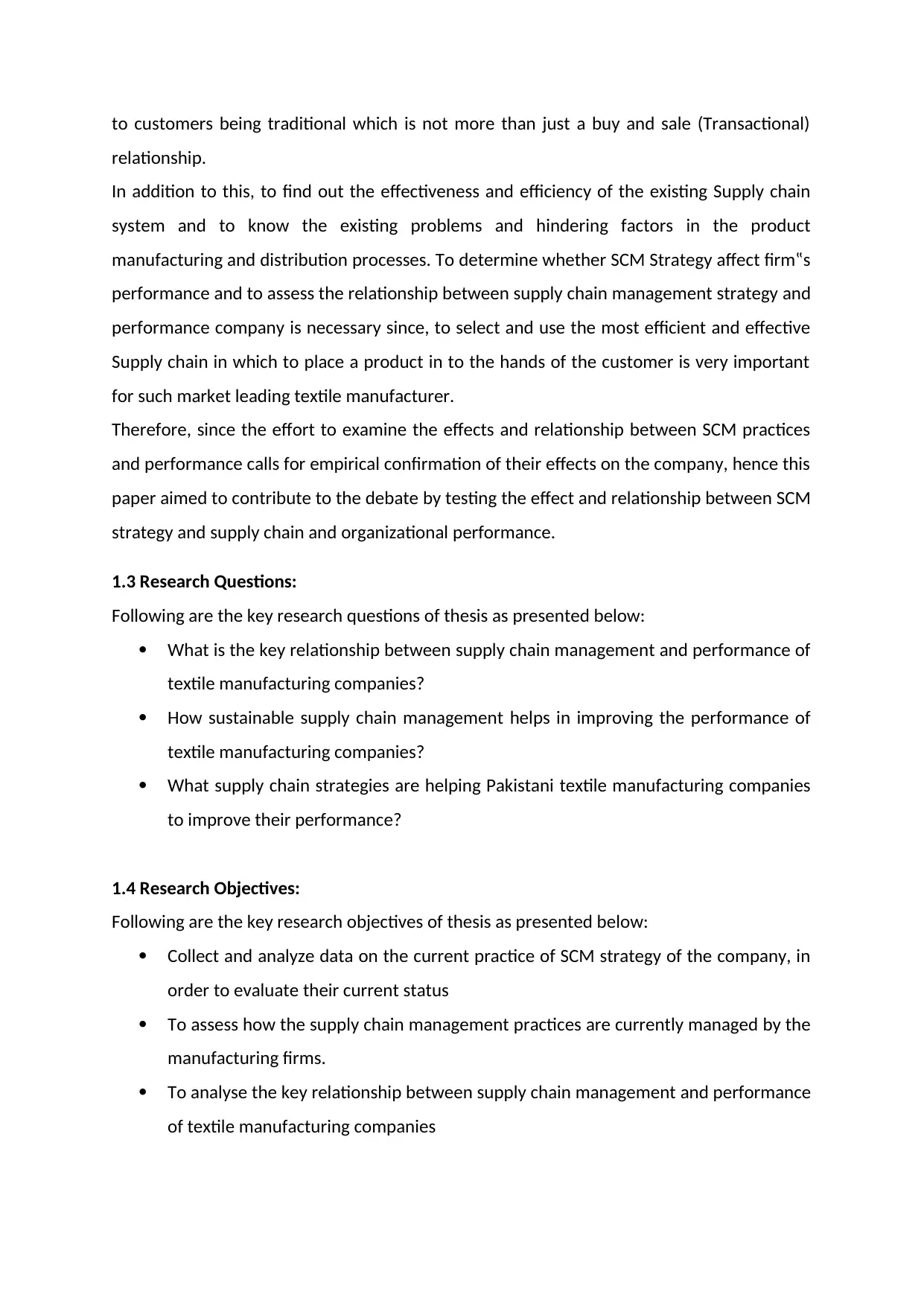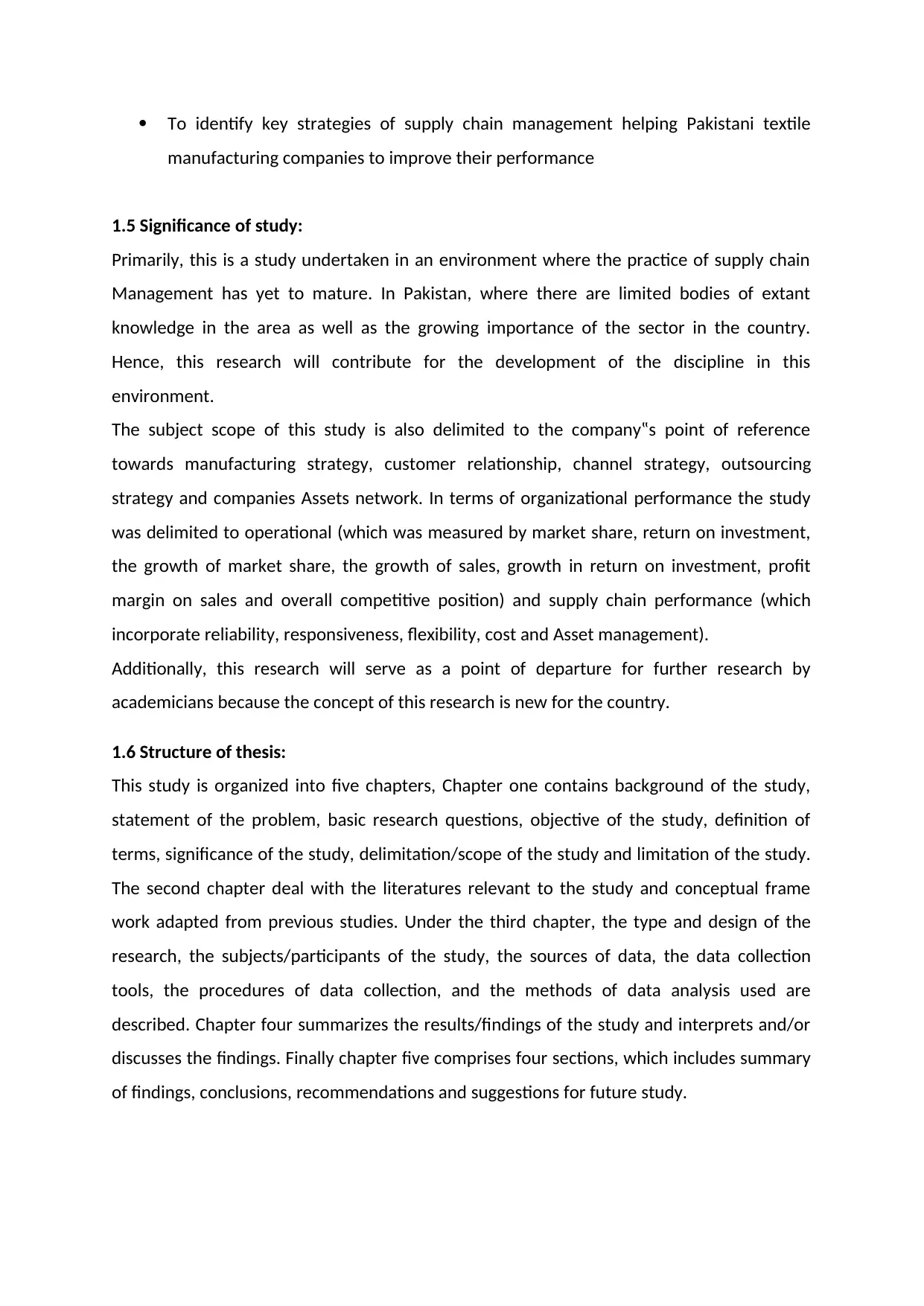The Relationships Between Supply Chain and Firm Performance
VerifiedAdded on 2021/06/01
|4
|1414
|39
AI Summary
Contribute Materials
Your contribution can guide someone’s learning journey. Share your
documents today.

Analysing the relationship between supply chain
management and performance of firm: a study
of textile industry, Pakistan
Chapter 1: Introduction
1.1 Overview:
Within the organization, supply chain refers to a wide range of functional areas. These
include Supply Chain Management related activities such as inbound and outbound
transportation, warehousing, and inventory control (Khan et al., 2018). Sourcing,
procurement, and supply management fall under the supply chain umbrella, too.
Forecasting, production planning and scheduling, order processing, and customer service all
are part of the process as well. Importantly, it also embodies the information systems so
necessary to monitor all of these activities. (Zigiaris, 2017 p.1)
“Supply chain management encompasses the planning and management of all activities
involved in sourcing and procurement, conversion, and all logistics management activities.
Importantly, it also includes coordination and collaboration with channel partners, which
can be suppliers, intermediaries, third party service providers, and customers. In essence,
supply chain management integrates supply and demand management within and across
companies.” (Ali and Bodla, 2017).
A few years ago, logistics and SCM were seen as necessary evils, today they are seen as a
matter of survival and competitive advantage. As companies look at logistics and SCM
strategically, they turn to specialized service providers to cut out non-core activities from
within. A rising focus on outsourcing is leading to a surge in business performance for
logistics service providers. (Srivastava, 2016 p.1)
In present day there is an assumption that SC‟s should compete instead of companies, being
the SC‟s success mainly determined by the marketplace. Therefore, SCM is considered as a
strategic factor for the better attainment of organizational goals such as enhanced
management and performance of firm: a study
of textile industry, Pakistan
Chapter 1: Introduction
1.1 Overview:
Within the organization, supply chain refers to a wide range of functional areas. These
include Supply Chain Management related activities such as inbound and outbound
transportation, warehousing, and inventory control (Khan et al., 2018). Sourcing,
procurement, and supply management fall under the supply chain umbrella, too.
Forecasting, production planning and scheduling, order processing, and customer service all
are part of the process as well. Importantly, it also embodies the information systems so
necessary to monitor all of these activities. (Zigiaris, 2017 p.1)
“Supply chain management encompasses the planning and management of all activities
involved in sourcing and procurement, conversion, and all logistics management activities.
Importantly, it also includes coordination and collaboration with channel partners, which
can be suppliers, intermediaries, third party service providers, and customers. In essence,
supply chain management integrates supply and demand management within and across
companies.” (Ali and Bodla, 2017).
A few years ago, logistics and SCM were seen as necessary evils, today they are seen as a
matter of survival and competitive advantage. As companies look at logistics and SCM
strategically, they turn to specialized service providers to cut out non-core activities from
within. A rising focus on outsourcing is leading to a surge in business performance for
logistics service providers. (Srivastava, 2016 p.1)
In present day there is an assumption that SC‟s should compete instead of companies, being
the SC‟s success mainly determined by the marketplace. Therefore, SCM is considered as a
strategic factor for the better attainment of organizational goals such as enhanced
Secure Best Marks with AI Grader
Need help grading? Try our AI Grader for instant feedback on your assignments.

competitiveness, improved customer service and increased profitability. However, to ensure
a better SCM system it is important to develop a performance measurement system that
properly reflects the real SC‟s performance. Given a SC perspective, the performance
measurement is also strategic and essential because most companies realize that SCM
needs not only to be assessed for its performance but also SCM processes must be well-
defined and controlled.(Azevedo, Carvalho, and Cruz-Machado, 2011, p.7).
Therefore, the researcher is intended to empirically test the employees‟ perception towards
identifying the effect and relationships among SCM Strategies, SC performance and
organizational performance of the case company.
1.2 Problem statement:
According to Kluyver and Pearce, (2006, p. 4), the ultimate goal of strategy is “long-term,
sustainable superior performance.” Such superior performance now depends on the ability
of a manufacturing organization to become a fully integrated partner within a supply chain
context (Cooper et al., 1997), thus all manufacturing organizations required to adopt a
supply chain strategy. Such supply chain strategies focus on how both internal and external
business processes can be integrated and coordinated throughout the supply chain to better
serve ultimate customers and consumers while enhancing the performance of the individual
supply chain members (Cohen and Roussel, 2005 as quoted by (Green Jr, Whitten and
Inman, 2008)).
According to Green et al., (2008), Supply chain performance which is the “bottom line” for
supply chain strategies such as customer closeness versus operational excellence and their
enabling capabilities. Further, supply chain capabilities eventually devolve into supply chain
performance. It has been stated that the choice of a value discipline focus “shapes
everything a company does, colours the whole organization, and defines the very nature of
a company.
Yet limited researches has been accomplished in the area of SCM strategy and firms
performance in the Pakistani textile manufacturing companies (i.e. from perspectives of
Manufacturing strategy, Outsourcing strategy, Channel Strategy, Customer service strategy,
Asset network on Supply chain and organizational performances). Scientific study on such
knowledge gap is needed and this deficiency that the study seeks to fill. Furthermore, this
research has been motivated by existing gaps, namely lack of adequate knowledge of
managers in supply chain management the trend of managing supply chains from suppliers
a better SCM system it is important to develop a performance measurement system that
properly reflects the real SC‟s performance. Given a SC perspective, the performance
measurement is also strategic and essential because most companies realize that SCM
needs not only to be assessed for its performance but also SCM processes must be well-
defined and controlled.(Azevedo, Carvalho, and Cruz-Machado, 2011, p.7).
Therefore, the researcher is intended to empirically test the employees‟ perception towards
identifying the effect and relationships among SCM Strategies, SC performance and
organizational performance of the case company.
1.2 Problem statement:
According to Kluyver and Pearce, (2006, p. 4), the ultimate goal of strategy is “long-term,
sustainable superior performance.” Such superior performance now depends on the ability
of a manufacturing organization to become a fully integrated partner within a supply chain
context (Cooper et al., 1997), thus all manufacturing organizations required to adopt a
supply chain strategy. Such supply chain strategies focus on how both internal and external
business processes can be integrated and coordinated throughout the supply chain to better
serve ultimate customers and consumers while enhancing the performance of the individual
supply chain members (Cohen and Roussel, 2005 as quoted by (Green Jr, Whitten and
Inman, 2008)).
According to Green et al., (2008), Supply chain performance which is the “bottom line” for
supply chain strategies such as customer closeness versus operational excellence and their
enabling capabilities. Further, supply chain capabilities eventually devolve into supply chain
performance. It has been stated that the choice of a value discipline focus “shapes
everything a company does, colours the whole organization, and defines the very nature of
a company.
Yet limited researches has been accomplished in the area of SCM strategy and firms
performance in the Pakistani textile manufacturing companies (i.e. from perspectives of
Manufacturing strategy, Outsourcing strategy, Channel Strategy, Customer service strategy,
Asset network on Supply chain and organizational performances). Scientific study on such
knowledge gap is needed and this deficiency that the study seeks to fill. Furthermore, this
research has been motivated by existing gaps, namely lack of adequate knowledge of
managers in supply chain management the trend of managing supply chains from suppliers

to customers being traditional which is not more than just a buy and sale (Transactional)
relationship.
In addition to this, to find out the effectiveness and efficiency of the existing Supply chain
system and to know the existing problems and hindering factors in the product
manufacturing and distribution processes. To determine whether SCM Strategy affect firm‟s
performance and to assess the relationship between supply chain management strategy and
performance company is necessary since, to select and use the most efficient and effective
Supply chain in which to place a product in to the hands of the customer is very important
for such market leading textile manufacturer.
Therefore, since the effort to examine the effects and relationship between SCM practices
and performance calls for empirical confirmation of their effects on the company, hence this
paper aimed to contribute to the debate by testing the effect and relationship between SCM
strategy and supply chain and organizational performance.
1.3 Research Questions:
Following are the key research questions of thesis as presented below:
What is the key relationship between supply chain management and performance of
textile manufacturing companies?
How sustainable supply chain management helps in improving the performance of
textile manufacturing companies?
What supply chain strategies are helping Pakistani textile manufacturing companies
to improve their performance?
1.4 Research Objectives:
Following are the key research objectives of thesis as presented below:
Collect and analyze data on the current practice of SCM strategy of the company, in
order to evaluate their current status
To assess how the supply chain management practices are currently managed by the
manufacturing firms.
To analyse the key relationship between supply chain management and performance
of textile manufacturing companies
relationship.
In addition to this, to find out the effectiveness and efficiency of the existing Supply chain
system and to know the existing problems and hindering factors in the product
manufacturing and distribution processes. To determine whether SCM Strategy affect firm‟s
performance and to assess the relationship between supply chain management strategy and
performance company is necessary since, to select and use the most efficient and effective
Supply chain in which to place a product in to the hands of the customer is very important
for such market leading textile manufacturer.
Therefore, since the effort to examine the effects and relationship between SCM practices
and performance calls for empirical confirmation of their effects on the company, hence this
paper aimed to contribute to the debate by testing the effect and relationship between SCM
strategy and supply chain and organizational performance.
1.3 Research Questions:
Following are the key research questions of thesis as presented below:
What is the key relationship between supply chain management and performance of
textile manufacturing companies?
How sustainable supply chain management helps in improving the performance of
textile manufacturing companies?
What supply chain strategies are helping Pakistani textile manufacturing companies
to improve their performance?
1.4 Research Objectives:
Following are the key research objectives of thesis as presented below:
Collect and analyze data on the current practice of SCM strategy of the company, in
order to evaluate their current status
To assess how the supply chain management practices are currently managed by the
manufacturing firms.
To analyse the key relationship between supply chain management and performance
of textile manufacturing companies

To identify key strategies of supply chain management helping Pakistani textile
manufacturing companies to improve their performance
1.5 Significance of study:
Primarily, this is a study undertaken in an environment where the practice of supply chain
Management has yet to mature. In Pakistan, where there are limited bodies of extant
knowledge in the area as well as the growing importance of the sector in the country.
Hence, this research will contribute for the development of the discipline in this
environment.
The subject scope of this study is also delimited to the company‟s point of reference
towards manufacturing strategy, customer relationship, channel strategy, outsourcing
strategy and companies Assets network. In terms of organizational performance the study
was delimited to operational (which was measured by market share, return on investment,
the growth of market share, the growth of sales, growth in return on investment, profit
margin on sales and overall competitive position) and supply chain performance (which
incorporate reliability, responsiveness, flexibility, cost and Asset management).
Additionally, this research will serve as a point of departure for further research by
academicians because the concept of this research is new for the country.
1.6 Structure of thesis:
This study is organized into five chapters, Chapter one contains background of the study,
statement of the problem, basic research questions, objective of the study, definition of
terms, significance of the study, delimitation/scope of the study and limitation of the study.
The second chapter deal with the literatures relevant to the study and conceptual frame
work adapted from previous studies. Under the third chapter, the type and design of the
research, the subjects/participants of the study, the sources of data, the data collection
tools, the procedures of data collection, and the methods of data analysis used are
described. Chapter four summarizes the results/findings of the study and interprets and/or
discusses the findings. Finally chapter five comprises four sections, which includes summary
of findings, conclusions, recommendations and suggestions for future study.
manufacturing companies to improve their performance
1.5 Significance of study:
Primarily, this is a study undertaken in an environment where the practice of supply chain
Management has yet to mature. In Pakistan, where there are limited bodies of extant
knowledge in the area as well as the growing importance of the sector in the country.
Hence, this research will contribute for the development of the discipline in this
environment.
The subject scope of this study is also delimited to the company‟s point of reference
towards manufacturing strategy, customer relationship, channel strategy, outsourcing
strategy and companies Assets network. In terms of organizational performance the study
was delimited to operational (which was measured by market share, return on investment,
the growth of market share, the growth of sales, growth in return on investment, profit
margin on sales and overall competitive position) and supply chain performance (which
incorporate reliability, responsiveness, flexibility, cost and Asset management).
Additionally, this research will serve as a point of departure for further research by
academicians because the concept of this research is new for the country.
1.6 Structure of thesis:
This study is organized into five chapters, Chapter one contains background of the study,
statement of the problem, basic research questions, objective of the study, definition of
terms, significance of the study, delimitation/scope of the study and limitation of the study.
The second chapter deal with the literatures relevant to the study and conceptual frame
work adapted from previous studies. Under the third chapter, the type and design of the
research, the subjects/participants of the study, the sources of data, the data collection
tools, the procedures of data collection, and the methods of data analysis used are
described. Chapter four summarizes the results/findings of the study and interprets and/or
discusses the findings. Finally chapter five comprises four sections, which includes summary
of findings, conclusions, recommendations and suggestions for future study.
1 out of 4
Related Documents
Your All-in-One AI-Powered Toolkit for Academic Success.
+13062052269
info@desklib.com
Available 24*7 on WhatsApp / Email
![[object Object]](/_next/static/media/star-bottom.7253800d.svg)
Unlock your academic potential
© 2024 | Zucol Services PVT LTD | All rights reserved.





